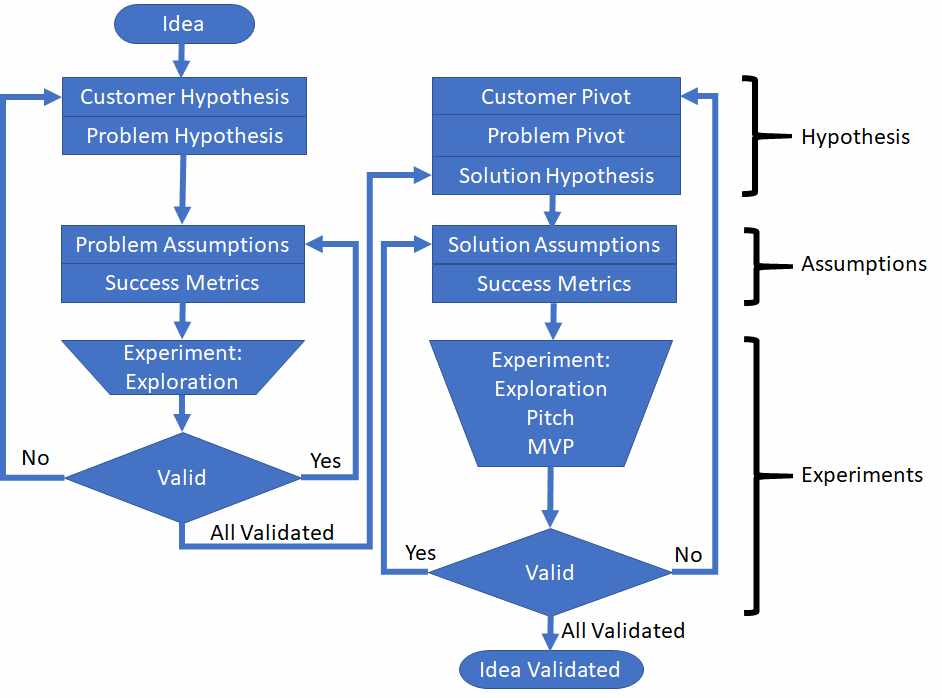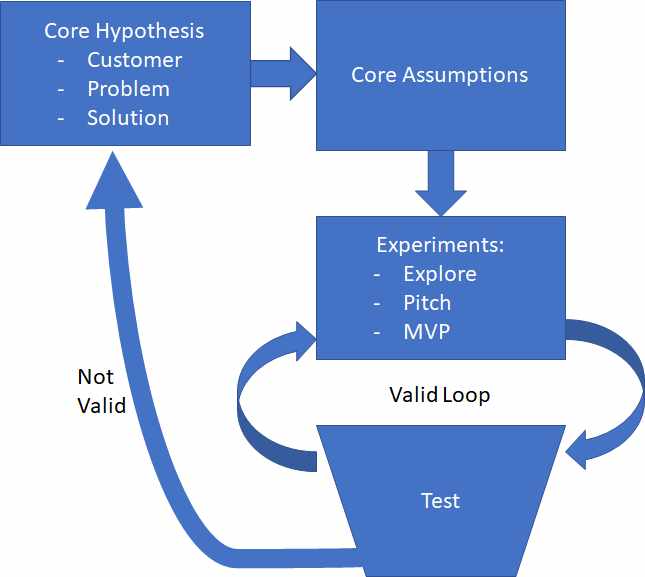As a mentor to thousands of clients over the years, one question I get most of the time is to render an opinion about the client’s business idea. It’s easy to get carried away and invest time and money without conducting a business case validation. The process that I recommend to assess or validate a business idea starts with defining and validating your core hypotheses, followed by identifying and validating the core assumptions your hypotheses were based upon and then testing them one at a time.
Business Plan vs Idea Validation
Let me begin by saying that the standard advice when a person wants to start a new business is to write a business plan. I hate that answer because a business plan is all about execution. The assumption is that you have a verified solution and the business plan is how you plan to create a business to get people to buy your solution.
When a person has an idea for a new product or service, the first step is not to define how they are going to implement their idea but to validate if the customer has a problem and more importantly, is willing to pay for a solution. Did you know that product-market fit is one of the most common reasons that businesses fail? Just because you think everyone will love and pay for your solution does not mean it is true.
The first question should not be “how do I implement my idea? but “what do I need to know in order to validate that the problem is real and that customers are willing to pay for my solution?”
Rather than writing a business plan as the first step in setting up a business, my advice is to follow the lean-startup process and do a business validation test on your business idea and solution first. It is far better to find out early that you need to change your solution before investing time and money on a business idea that no one needs.
Whether you start by creating a business model canvas to define and validate your business idea so you can tease out all your leap of faith assumptions or you just have a nugget of an idea and don’t know where to start, you absolutely need to start the process by validating your business idea first.
Why Should You Validate a Business Idea?
Most of the products that you are familiar with and enjoy were not originally conceived to be what they are today.
- Instagram was originally an app that would let you check-in at a location.
- YouTube started as an online dating site called “Tune In Hook Up”.
- Facebook started life as “FaceMash” that allowed Harvard students to compare other students’ pictures and pick the one that was the hottest.
They all made pivots along the way as they learned new things about how customers used their solution, until they found the solution that customers really loved and supported. Once these businesses could show traction in their idea, they were able to go and raise risk capital and scale their solutions into the products we know today.
The process most businesses are told to follow is to:
1. Write a business plan.
2. Start a business.
3. Attract investors or get a loan.
4. Use the money to develop your new product or service.
5. Deliver your solution.
6. Validate market acceptance of your solution.
This process is a recipe for financial ruin and is why, in my opinion, many businesses fail. Instead, I recommend to my clients to flip or reorder the process.
1. Validate that your business solution idea resonates with customers.
2. Build a prototype solution based upon your validated assumptions.
3. Complete a business model canvas and or business plan.
4. Attract partners or investors
5, Use the investor’s money or partners to finalizing your solution.
6. Start a business to sell and scale your solution.
Recently, I met with a client who was a former school principal and at the time of this writing, the COVID-19 pandemic was still a concern and the 2020-2021 school year was about to begin. His goal was to start his own school. Since there was a lot of discussion about whether or not to open schools given the ongoing pandemic, we agreed that the best solution had to be an alternative to the traditional classroom.
The following is the process I recommended to him and that I recommend everyone to follow to validate a business idea before they start a business. I will use my client’s experience to convey the message in a real-world example.
The Process to Validate a Business Idea

Although the flow chart looks as complex as some of those sales funnels many marketing and sales gurus encourage, the process to validate a business idea really only consists of 3 steps. Step one is defining your hypotheses. Step two is identifying the assumptions your hypotheses were based upon. And step three is running a few experiments to test your assumptions one at a time.
Define Your Core Hypothesis
Your core hypothesis is made of three elements: a customer hypothesis, a problem hypothesis, and a solution hypothesis that comes only after you have validated your problem hypothesis. Using a tool like the Opportunity Canvas can help you forcing you to examine the problem in detail, propose a solution, and connect with the customer to help them determine if their idea is worth building a business around.
Customer Hypothesis
When we are defining your customer hypothesis, we are not looking to define the primary customer archetype in terms of demographics. Instead, you want to define them by their actions. For example, the initial customer hypothesis we suggested to our school principal was:
Problem Hypothesis
Once you define the customer hypothesis, then define the specific problem that you feel the customer faces. For example, the initial problem hypothesis we suggested for our school principal was twofold:
Parents need to send their kids to a supervised learning facility during the school day so they can go to work.
A large number of teachers have health concerns and are afraid of returning to the traditional school and classroom environment.
Solution Hypothesis
If this is the first time through the process, there is minimal value in coming up with a solution hypothesis because you have not yet validated that there is even a problem. Technically, you would not define a solution hypothesis until you validate that customers have a problem, however it’s likely that the only reason you considered starting a business and began this process in the first place is based on the fact that you believe you have found a solution to an identified problem. Just avoid the temptation of being a solution in search of a problem, but rather validate the problem before you spend any time on a solution.
Once you validate the problem hypothesis by conducting experiments, that we will discuss further along, you can define your solution hypothesis.
List Your Problem Assumptions
Next, we want to define our problem assumptions for our hypothesis. The 5-whys and a fishbone diagram are effective ways to reveal your problem assumptions. For example, after brainstorming for a while with our school principal, here are some of the problem assumptions we suggested he explore:
- Parents did not fear the health risks of sending their kids back to school.
- Not all students had their own laptops and access to the Internet.
- Teachers were less willing to return to traditional classrooms for fear of contracting COVID-19 from the students and other staff members.
- Many teachers had underlining health issues that placed them at greater risk of complications if they contracted COVID-19.
- Schools did not have to be massive institutions with hundreds of students to be efficient.
- Students did not have to be sorted into classes based upon grade level or subject matter.
- Some parents would pay for an alternative option to district funded schools.
- Teachers could be remote and students could be in a classroom since students were far less likely to contract COVID-19.
- An older student could help a younger student learn.
Design Experiments to Validate Assumptions
Review your list of problem assumptions and choose the riskiest assumption, because if it is invalid, then you will need to consider a pivot. The reason for choosing a single risky assumption is to save time. It takes time to validate each assumption and by choosing the riskiest assumption first, we have the highest chance of finding an invalid assumption which will force us to reconsider our core hypothesis and come up with a pivot.
For example, the riskiest problem assumption we suggested that our school principal start with was:
Parents did not fear the health risks of sending their kids back to school.
Now that you have selected the assumption that is the riskiest, the next step is to design a series of experiments to test the riskiest assumption to get you one step closer to validating your core hypothesis.
Experiments should follow a 3-step process. Each step in the 3-step process becomes increasingly more expensive and time-consuming so I recommend you implement them in the following order. If after any one of the steps your experiment proved that your core hypothesis was invalid, you can simply stop and reexamine your core hypothesis again to see if a pivot is in order.
The 3-Step Experiment Method
1. Exploration – This is where you do customer interviews to discover or verify their pain points. For example, we suggested to our school principal that he:
Find Facebook groups dealing with the issue of sending kids back to traditional classrooms and create a survey. We also suggested going to the supermarket with a clipboard and interviewing parents with kids on how they felt about sending their kids back to school.
The exploration step is the least expensive way to test your assumptions, so I recommend that my clients test all of their initial problem assumptions.
One innovative tactic I have come across, in order to conduct the exploration step of a product with potential customers, begins by creating a fake Craigslist ad for a similar type of product. When a person calls in response to the ad, they simply come clean and say that the product was never really available, but could they ask them a few related questions as they were getting ready to launch a similar product and they would keep them posted on their progress. To their surprise, none of the callers were pissed off at the bait and switch tactic and agreed to answer their questions.
2. Pitch – This is where you discover if the customer is willing to exchange something of value, usually money, for your solution. At one extreme is simply asking for a person’s email address since it is a currency of sorts and not something someone gives away for free on the other extreme is requesting a full-price commitment from the customer. In between are lots of other options to test your pitch.
One very successful pitch method is to employ the 3-page website where page one is a long-form sales page, page two collects credit card information, and page three says out of stock. For the 3-page website, you would buy a few targeted Facebook ads to promote your long-form sales page to gain some traffic.
Another option is a pre-sale where you offer people an opportunity to buy your product or service at a discount rate if they are willing to secure their purchase with a deposit. Remember, the goal at this point is only to see if they will pay for your product or service.
A third option is to run a reward-based crowdfunding campaign to ensure people are willing to exchange money for your solution.
3. MVP – This is where you deliver an element of the solution to just a few potential customers with limited technology until you find out what makes them fall in love with your solution. MVP is an acronym that stands for Minimally Viable Product.
Your MVP should have enough value so that a customer will use it, should provide clues to how the final solution will look and function, and should generate sufficient data that you can use to refine your final solution.
Rather than develop an app, you could demo the product with a series of simple screenshots. You could use google forms to collect data from the users and rather than use code to provide the solution, you could manually prepare the output. The key is making something to test your assumptions without doing all the engineering work to create a functioning product.
Minimal Success Criteria
Now that you have defined the experiment method, the next step is to define the minimum success criteria that will justify further work on developing your solution. For our school principal, for example, he may determine the minimum success criteria for the initial exploratory step as:
Greater than 50% of parents surveyed must agree to send their kids back to a physical classroom setting.
Test Your Assumptions
At this point, it is time to leave the safety of the office or your home and run the exploration experiments with real people. If you validate your most risky assumption, then you should proceed to the next riskiest assumption and so on until you have validated each assumption.
If you have validated all of your initial problem assumptions, you can develop your solution hypothesis in earnest. For our school principal, we brainstormed a solution hypothesis that looked something like this:
Recreating a series of old one-room schoolhouses where a small group of students of various ages convene each day in the same class with a single facilitator (not necessarily a teacher), and several teachers remotely connect with a subset of students across multiple classrooms to teach lessons. Older students would be enlisted to help the younger students complete their in-class assignments.
Once you have defined a solution hypothesis it is time to define your solution assumptions and success metrics and then follow the 3-step experiment method to test your solution assumptions, this time being sure to include the pitch and MVP steps.
If any of your experiments prove that your core hypothesis is invalid, you will have two options. You can readdress your core hypothesis and brainstorm a pivot, or you can decide to just scrap the entire idea. If, however your run through all your solution assumptions and they each have been validated by meeting your success metrics, it is time to lay out your complete business idea in a business model canvas if you require investors or partners or to build your solution.
How to Validate a Business Idea Conclusion
Hopefully, you can see the value of this lean startup approach of validating a business idea first. Imagine if you had not received this kind of valuable feedback early on and spent time and money to develop your product or service solution only to discover it did not have a good product-market fit. By that time, you very well may have launched your new product or service but with no traction, you would have likely burned through all your seed money. Any feedback that you would have received to improve the product or service after launch may never make it into a pivot because you are out of money. I have seen this kind of scenario played out too many times to count. Don’t be a statistic – learn to validate a business idea first.
Do you validate a business idea before you make plans to start a business?












